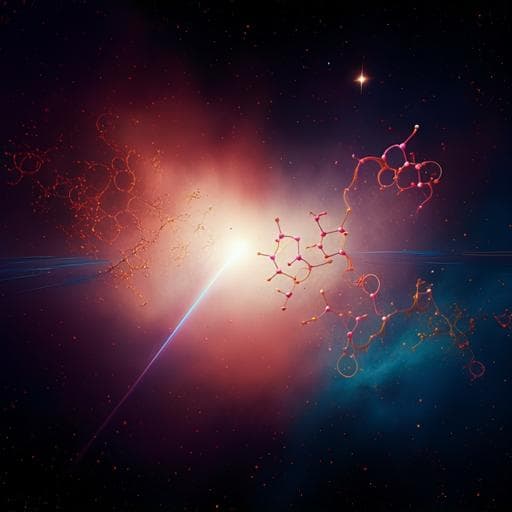
Space Sciences
Identification and characterization of a new ensemble of cometary organic molecules
N. Hänni, K. Altwegg, et al.
Discover the intriguing findings from the in-situ study of comets, revealing unexpected organic compounds in cometary comas! Conducted by N. Hänni, K. Altwegg, M. Combi, S. A. Fuselier, J. De Keyser, M. Rubin, and S. F. Wampfler, this research uncovers a complex ensemble of organics from comet 67P/Churyumov-Gerasimenko, shedding light on its cosmic origins.
~3 min • Beginner • English
Introduction
Comets contain mixtures of refractory dust and ices spanning volatilities from super-volatiles to refractory materials. Past missions (e.g., to 1P/Halley) revealed abundant complex organics in cometary comae, but their structural nature—individual molecules versus decomposition products of polymers such as polyoxymethylene (POM)—remained unresolved due to limited mass spectral resolution. Rosetta’s high-resolution mass spectrometer (DFMS) at comet 67P/Churyumov-Gerasimenko enables reassessment of this question near perihelion, when enhanced dust activity can release larger organic molecules. The study aims to identify the molecular composition and structure of complex organics, quantify their relative classes (chain, cyclic, aromatic), test for signatures of polymeric matter, and compare their properties (elemental ratios, sp2:sp3, CH2:CH3, hydrogen deficiency index) with other Solar System and interstellar reservoirs to infer origins and processing history.
Literature Review
Earlier low-resolution mass spectrometry at 1P/Halley (Giotto/PICCA) showed signals up to ~100 Da, variously interpreted as either polymer fragments (notably POM) or ensembles of individual molecules. Vega 1/PUMA also supported individual organics associated with dust. Distributed sources of species like formaldehyde and CO were attributed to polymer decomposition, though later work showed such profiles could arise from variable outgassing. Stardust samples from 81P/Wild 2 indicated O- and N-rich organics with aromatic moieties but could not conclusively distinguish polymers from complex molecules. For 67P, prior surveys identified volatile small molecules and pure hydrocarbons up to heptane (~100 Da). Dust studies indicated refractories comprising minerals and macromolecular organics (CHON-like) with ~50% mass each. The lack of high-resolution fragmentation data previously limited structural assignments and polymer discrimination.
Methodology
In situ measurements were performed with ROSINA/DFMS (Nier-Johnson double focusing mass spectrometer; m/Δm ≈ 3000 at m/z 28 at 1% peak height) aboard Rosetta near perihelion on 3 August 2015 when 67P was at 1.249 au and dust activity was high. The spacecraft was ~215 km from the nucleus. Neutral species from the nucleus and heated dust were ionized by 45 eV electron impact ionization (EII), producing molecular ions and characteristic fragment ions. m/z 13–140 were scanned in modes 222, 562, 564 over 15:03–16:39 UTC with overlapping ranges to correct temporal drifts. Post-acceleration (1000 V) increased detection efficiency above m/z 70. Peak areas from high-resolution spectra (two detector rows) were sensitivity-corrected to yield intensities (arbitrary units). Uncertainties combined counting statistics (≈20% for m/z >100), peak-fit/pixel-gain (~15%), and drift (corrected via overlaps; residual ≈15%), yielding ~30% uncertainty for m/z <100 and ~50% for m/z >100. Stacking spectra was not used due to variability. For species identification and quantification: - Extensive use of EII fragmentation patterns from DFMS-calibrated references where available; otherwise NIST 70–75 eV unit-resolution spectra with noted caveats (DFMS at 45 eV enhances molecular ion; unit resolution conflates heteroatom-retaining vs hydrocarbon fragments). - Deconvolution focused first on the subset of pure hydrocarbons using an Occam's razor approach to minimize the number of molecules explaining the observed intensities. Structural isomer ambiguity was acknowledged; identifications prioritize strong and characteristic fragment patterns. - Heteroatom-bearing species were identified when distinctive molecular ion and key fragments were present (e.g., phenyl/tropylium signatures), but full deconvolution across all heteroatom classes was not attempted due to reference and resolution limitations. - To test for polymers, exact-mass windows at characteristic multimer signals were examined: m/z 91 for the POM linear trimer fragment (C3H7O3+) and m/z 140 for hexamethylenetetramine (HMT, C6H12N4+). Laboratory DFMS twin measurements with paraformaldehyde validated POM fragmentation signatures. - Structural metrics were computed for identified pure hydrocarbons: sp2:sp3 (by counting hybridized carbons and hydrogens) and CH2:CH3 ratios. - Average elemental composition was computed for all C-bearing neutrals of ≥4 atoms in the organic subset by weighting stoichiometric coefficients by signal intensities and normalizing to C. Inorganic C-bearing volatiles (CO, CO2, HCN, CS, COS) were excluded. Contributions from 12C were estimated from 13C under terrestrial isotopic ratios; similar corrections for heteroatoms were neglected as minor. Upper limits for near-isobaric overlaps were included at half value. Error propagation used 15% (m/z ≤100) and 35% (m/z >100) statistical uncertainties; systematic effects (e.g., species-dependent EII cross sections, unseen fragments outside m/z range) were considered to partly cancel, except that H/C is a lower limit due to unmeasured light fragments.
Key Findings
- Identification of an ensemble of individual volatile organic molecules in 67P’s coma up to m/z ~140 Da; non-carbon species are rare above m/z ~50 and noble gases (Kr, Xe) were not detected. - New cometary identifications (unambiguous on 3 Aug 2015) include nonane (C9H20), naphthalene (C10H8; confirmed), and benzylamine (C7H9N); benzoic acid (C7H6O2) is clearly confirmed; ethylene (C2H4) and propene (C3H6) are confirmed in 67P for the first time. - Pure hydrocarbons comprise three structural classes—chains (saturated/unsaturated; linear/branched), cyclic, and aromatic—with a summed relative abundance ratio of approximately 6:3:1 (±10% uncertainty). Ring-based structures (aromatic and non-aromatic) constitute a significant fraction; several are alkyl- or functionally substituted (e.g., benzoic acid, benzylamine; likely furane/pyrrole/thiophene derivatives). - Absence of polymer signatures: no detectable POM linear trimer fragment (C3H7O3+) at exact m/z 91; the strong m/z 91 signal is tropylium (C7H7+) from toluene fragmentation. No HMT (C6H12N4+) molecular ion at m/z 140. Prior DFMS lab calibrations with paraformaldehyde show that cometary spectra lack POM patterns; thus polymeric matter (POM/HMT) is, if present, of extremely low abundance. - Structural metrics for pure hydrocarbons: sp2:sp3 ≈ 0.3 (by carbon count) and ≈ 0.1 (by hydrogen count), implying roughly one-third of carbon atoms in double-bonded (aliphatic/aromatic) environments and low content of sp-hybridized carbons. CH2:CH3 ≈ 1.9, suggesting more extended/less branched aliphatic moieties than meteoritic IOM and diffuse ISM, but less than in Stardust cometary dust and IDPs (~2.5). - Average elemental composition of volatile organics (excluding CO, CO2, HCN, CS, COS) is C1H1.56±0.04O0.134±0.007N0.046±0.003S0.017±0.001. This closely matches meteoritic soluble organic matter (SOM) for H/C (~1.55) and heteroatom/C ratios, and aligns with Halley dust organics (PUMA) and Saturn’s ring rain organics (Cassini/INMS; especially when CH4 is excluded). COSIMA results indicate similar N/C but lower H/C for refractory organics, implying higher hydrogen deficiency in refractories compared to the volatile ensemble. - Hydrogen deficiency index (HDI) patterns and molecule sizes differ from ISM detections: cometary molecules are generally larger and less H-deficient; however, methodological biases (rotational spectroscopy vs mass spectrometry) limit direct census overlap. - Several aromatic families appear in multiple hydrogenation states (e.g., benzene ↔ cyclohexene ↔ cyclohexane; naphthalene ↔ dihydro/tetrahydro/decahydronaphthalene), consistent with hydrogenation/dehydrogenation processing history.
Discussion
The high-resolution DFMS dataset demonstrates that 67P’s complex organics are predominantly ensembles of individual molecules rather than fragments of abundant polymers. The lack of POM/HMT signatures directly addresses and resolves the longstanding polymer-versus-molecule debate from earlier low-resolution comet flybys. The structural distribution (significant cyclic and aromatic content; sp2:sp3 and CH2:CH3 ratios) and the average elemental composition strongly resemble other Solar System reservoirs (meteoritic SOM, Halley dust organics, Saturn ring rain), indicating conserved heteroatom/C ratios across environments and variable hydrogenation reflecting differing processing. Multiple lines of evidence support a pre-solar inheritance of these organics: (1) cometary ices match ISM ice compositions; (2) minimal chemistry during cold storage; (3) detection of some aromatics across large heliocentric and cometocentric ranges linked to ice sublimation rather than dust decomposition; (4) elevated D/H in linear alkanes and methanol relative to water and near refractory organics; (5) insufficient in-situ hydrogen sources to raise H/C without contradicting D/H; (6) weak neutral-ion chemistry in the tenuous coma. Together, these observations suggest cometary organics formed and were processed prior to comet assembly, with subsequent evolutionary effects modulating hydrogenation but largely preserving heteroatom abundances. Differences from the ISM census (e.g., fewer radicals or polyynes in comet data) reflect both environmental chemistry and observational biases between rotational spectroscopy and mass spectrometry.
Conclusion
This study identifies and characterizes a new ensemble of complex volatile organic molecules in comet 67P up to ~140 Da, comprising chain, cyclic, and aromatic hydrocarbons in a ~6:3:1 ratio and including several first cometary detections. High-resolution mass spectrometry shows no evidence for significant polymeric materials such as POM or HMT in the volatile coma. The ensemble’s average composition (C1H1.56O0.134N0.046S0.017) and structural metrics align closely with meteoritic SOM and other Solar System organic reservoirs, supporting a scenario of pre-solar origin with later environmental processing affecting hydrogenation. Future work should expand DFMS-calibrated reference libraries, deepen analysis of heteroatom-bearing species (including heterocycles), investigate radicals and polyynes, and perform detailed comparative studies with Cassini/INMS ring-rain organics and with evolving ISM molecular inventories to further elucidate formation pathways and evolutionary links.
Limitations
- Structural isomer ambiguity is inherent to mass spectrometry; many isomers share similar EII fragmentation patterns, and reference spectra are incomplete, especially for larger molecules, radicals, and certain classes (e.g., polyynes). - Heteroatom-bearing species could not be fully deconvolved due to reliance on unit-resolution NIST data (70–75 eV) versus DFMS conditions (45 eV), which affects fragmentation ratios and obscures separation of hydrocarbon versus heteroatom-retaining fragments at identical integer m/z. - The scanned mass range was limited to m/z ≤140; contributions from higher-mass organics may be underrepresented. - Species-dependent ionization cross sections and detector responses are imperfectly known, affecting absolute abundances; reported intensities are in arbitrary units and group-sum ratios are more reliable than single-molecule abundances. - Temporal and spatial variability (slews, rotation, compositional changes) introduce drift; overlap-based corrections leave residual systematic uncertainties (~15%). - H/C is a lower limit in the average composition calculation due to unmeasured low-mass fragments; assumptions about isotopic contributions and upper-limit handling add uncertainty. - Identification of certain heterocycles and aromatics remains tentative; some unexplained intensity may arise from unmodeled classes (e.g., alkanols) or from species lacking reference spectra.
Related Publications
Explore these studies to deepen your understanding of the subject.







